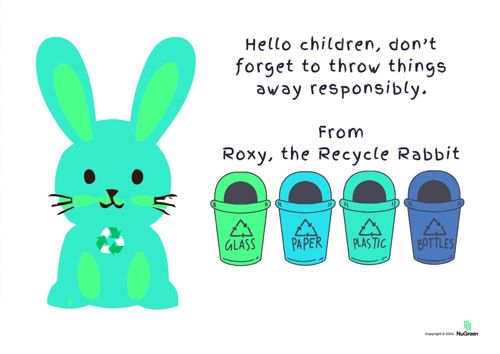NuGreen Sustainable Advice Framework for Primary Schools Climate Action Plans.
NuGreen Sustainable Advice Framework
This document is designed as a practical guidance document to support primary schools in their implementation of a climate action plan, giving a context to reporting and signposting both national and local resource recommendations for individual settings.
What is sustainability?
The UK government defines sustainable development as development that meets the needs of the present without compromising the ability of future generations to meet their own needs.
Sustainability is not just about reducing your carbon footprint, or single use plastic, the UN outline 17 different Sustainability Development Goals ranging from Quality Education to Peace, Justice and strong Institutions which identifies the way sustainability should be woven into all aspects of our everyday lives.
Perhaps the most relatable element of sustainability to schools however, is that it is about protecting our planet for now and the future, and the creation of a better world for all across all aspects, a notion frequently taught in Primary Schools. Sustainability is ultimately about being more efficient in your resource use and your practices, for example, by becoming more efficient, you will see a reduction in your costs and carbon emissions. Whilst also considering your impact on the wider aspects of sustainable living, for example perhaps the study of what peace and justice means in a setting like your school or the actions taken to support zero hunger by donating food to local food bank each year.
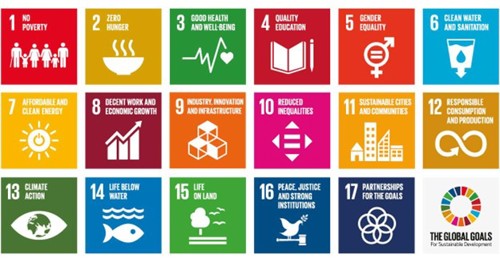
Being sustainable is more expensive and time consuming right?
Short answer, no. As just mentioned, being sustainable is efficient, and with that can come a reduction in your costs e.g. if you and a colleague are booked on training course, by lift sharing rather than driving separately, there will be only one journey to expense rather than two, and less fuel being burnt! Longer answer, there might be an initial investment into being sustainable, but you will see a return on investment in the long term e.g. investing into a ground source heat pump may have an initial financial outlay, but will reduce your bills in the long term. There is some initial time required to gather some information and usually fill in a few forms but once you are up and running its not too time intensive.
Where do I start?
There are simple steps to help you on your way. Sustainability can seem a daunting and intimidating task, many find themselves overwhelmed with not knowing where to start, but this does not have to be the case.
The Strategic aims of Government policy document “The Sustainability and climate change: a strategy for the education and children’s services systems” are as follows:
- Excellence in education and skills for a changing world
- Net zero
- Resilient to climate change
- A better environment for future generations
“By 2025, all education settings will have nominated a sustainability lead and put in place a climate action plan”.
Small, simple and incremental steps are a great place to start, they will eventually snowball into the next project, then onto a bigger project, and then another. Before you know it, you will be well on your way to net zero and now looking to sustain your impact. Remember that sustainability is not just a one-time action, it is a constant effort stretching generations. Below is our framework on beginning and maintaining your sustainability journey.
Stage One: Collect
Start by identifying a sustainability lead and team, one person doesn’t have to do all the work but perhaps could co-ordinate lots of small tasks across the school divided by classrooms or staff members. Perhaps this person will complete training on behalf of the school and bring back their findings for continued learning and sustainable changes in school.
Before you act, you need to know where you are currently, otherwise you will not know where the opportunities for sustainable improvement are. Auditing yourself will give you insight into each aspect of your organisation and highlight key impact areas for sustainable interventions.
What to audit:
- Waste – Understanding your waste gives a bottom-up approach to looking at the flow of materials throughout your school. Start measuring what you are throwing and how much of it (e.g. kg of glass, plastic, paper). A biannual or annual waste composition audit will identify what specific items are being disposed of, and if they are going in the correct bin. Correct segregation can reduce your carbon emissions substantially for example general waste perhaps is incinerated, however plastic, cardboard and aluminium can all be recycled. Ensuring recyclates do not end up in general waste, would reduce the amount of waste being incinerated and keep recyclable materials in use for longer.
- Food – Knowing what food you are throwing away, empowers you to keep it from reaching the bin altogether. Auditing your food waste, although potentially messy, is simple. First you should identify the areas where food waste would end up e.g., canteen, kitchen and staff rooms. Similar to the previous advice on auditing waste, ensure you separate the food by where it was disposed of, and then by food type. We recommend categorising the food waste by: food prep wastage, out of date, packed lunch, unfinished school dinners. This way you can accurately identify the source of the food waste and where interventions can be made e.g., if there is lots of food being waste from kitchen prep then you would know that further training and support is required for the cooks, or if there are many unfinished school dinners it could be worth looking at portion sizes and surveying the students on why they are not being finished.
- Energy – Reducing your energy bills will also reduce your carbon footprint, as fossil fuels are burnt in the production of electricity and gas/oil is burnt for heat, and this is the easiest area to make the biggest impact. Start tracking your kWh per month (or each day if you can) and use your energy supplier’s average CO2e / kWh to calculate your footprint. If you can, consider switching to a supplier who only uses renewable energy, such as Octopus. There is a trial initiative to work with Energy Sparksto trial the delivery of Energy Management Systems in schools this will give you access to real-time information about your energy usage, presented within a user-friendly online portal. Checking the temperature settings and turning down even one degree can offer significant carbon and financial savings.
- Water – Although seemingly abundant, potable water can have shortages and there is a footprint associated with treating it. Start tracking your water meter the same as your energy kWh. Checking the temperature of running water isn’t to hot and turning it down a degree of two can offer significant carbon and financial savings.
- Travel and commuting – The simplest way to record your travel is by using postcode to calculate the typical distances staff and pupils will take to and from school each day, and keeping track of the travel associated with trips. For example for staff commuting, add together the round-trip mileage from home to school for each staff member, as well as how many days a week they are in the office, and record the mode of transport. The easiest way to calculate the carbon footprint for all the recorded mileage you know have, is to find averages for each mode of transport and fuel type from reputable sources. A more difficult, but more accurate method, would be to find the exact CO2e/mile for each specific vehicle. This would take a lot of time, and it is better to start simple.
- School/staff satisfaction – Staff happiness comes under the wholistic view of sustainability and ESG. Happier and more engaged staff increases productivity and wellness in the community. Start by sending out anonymous staff surveys to gauge your team’s satisfaction. Ensure the questions in the survey cover a range of work placed topics. There is plenty of advice on what to ask online, to ensure compliance with ESG, and Microsoft Forms is an easy way to do it anonymously.
- Family/ pupil satisfaction – How you operate with your pupils and their families within your school is a large contributor to your impact on the community. If not already doing so, ask pupils and/ or parents to fill out short feedback surveys about school, try asking questions that are related to your wholistic sustainable performance.
- Policies and procedures – Reviewing your current policies and procedures is an incredibly useful tool to identify if your organisation is set up to support a sustainable working environment. You need the right policies and procedures in place, which are adhered to, to embed a sustainable culture and to gain staff engagement in your sustainable initiatives. Start by seeing if there is anything outdated e.g., strict dress code, or if there is opportunity to reduce emissions from operations e.g., opting to choose train over car where feasible.
- Buildings – Have a look at heating such as radiators, windows, (double/ triple glazing), lighting (LED/ non LED) and insulation (walls and ceilings), waste infrastructure (septic tank), identify any draughts. It is a great option to have a look yourself to identify areas you think need improvement, you might need a buildings expert to support any large infrastructure changes you require such as cavity wall insulation.
There are many free platforms online where you can input your data into, and it will automatically calculate your footprint with the most recent average coefficients available from the UK government, such as www.carbonplanner.natwest.com. The tool is quick, easy and free to use. The Centre for Sustainable energy also offer a simple but comprehensive building audit checklist that will help you on your way to understanding how you might reduce energy consumption and reduce losses such as heat, water, energy etc Energy survey for community buildings.
Stage Two: Analyse
Now you have all your data, you need to analyse it to identify key impact areas and opportunities for sustainable change. It does not take a professional data analyst to do this, often the platforms you may have used to input your data will provide you with insight into your consumption and impact.
Using the examples of the NuGreen trackers below, you can see that
An example of a potential solution would be solar panels or an air-sourced heat pump to heat the school.
Electricity: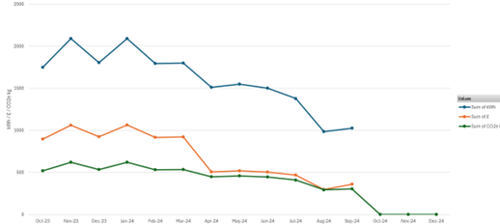
Oil:

Water:
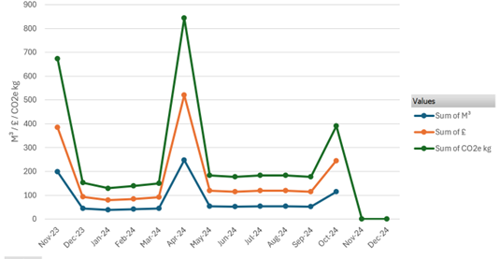
Waste:
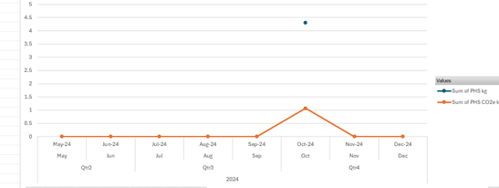
Staff commuting:
|
Commuting |
|||||
|
Petrol |
Diesel |
Electric |
Bus |
Active |
|
|
5 |
9 |
|
|
2.2 |
|
|
6.2 |
14.4 |
|
|
|
|
|
2 |
9.5 |
|
|
|
|
|
5 |
9.4 |
|
|
|
|
|
3 |
14 |
|
|
|
|
|
2.5 |
|
|
|
|
|
|
3.3 |
|
|
|
|
|
|
3.5 |
|
|
|
|
|
|
4 |
|
|
|
|
|
|
11.4 |
|
|
|
|
|
|
36 |
|
|
|
|
|
|
8.8 |
|
|
|
|
|
|
3 |
|
|
|
|
|
|
Total Miles per day |
93.7 |
56.3 |
0 |
0 |
2.2 |
|
Total Miles per week |
468.5 |
281.5 |
0 |
0 |
11 |
|
Average |
7.21 |
11.26 |
|
|
2.20 |
|
Per week average |
36.04 |
56.30 |
|
|
11.00 |
|
Total CO2e kg per day |
19.77 |
11.88 |
|
|
0 |
|
Total CO2e kg per week |
98.85 |
59.40 |
|
|
0 |
|
Average CO2e kg |
1.52 |
2.38 |
|
|
0 |
|
Average CO2e kg per week |
7.60 |
11.88 |
|
|
0.00 |
Stage Three: Implement
Now it is time to act. Using the analysis, create achievable and measurable targets, and build data-driven strategies to help reach your goals. For example, if you decide that you want to reduce your School energy consumption by 10%, look to switch off computers at night and lights when the room is not in use, study all your data sets and consider where small adjustments might be made. Other examples are shown below:
Internet
The carbon footprint of the internet is not commonly considered by its users, but it can actually have a significant impact on your school emissions profile. Follow these helpful tips to reduce your emissions while surfing the web.
- Use a carbon calculator to evaluate the carbon footprint of your internet usage. To determine what the approximate carbon impact of your internet usage is, understand where it comes from, and analyse offset options e.g. searching with Ecosia, and try a carbon calculator like the one provided by EcoTree.
- Surf the web efficiently. Type a website in the address bar instead of using a search engine to access it and mark regularly visited websites as favourites. Use search engines such as Ecosia who use profits towards reforestation projects. On your smartphone, stop infrequently used apps from running in the background.
- Reduce the carbon impact of your emails. Compress large documents and the size of attachments to reduce the weight of your emails. Empty your junk mail and unsubscribe from newsletters you no longer read. If sending files to internal contacts, share the link or file directly through SharePoint rather than emailing an attachment.
Paper
When printing a hardcopy is required, remember to:
- Reduce paper load in printing wherever possible. Reuse one-sided paper, print double-sided, and eliminate blank pages from documents before printing.
- Source paper sustainably. Select paper with a high-recycled content that is produced with sustainable-sourced materials, such as that which has received FSC verification.
Sustainable Procurement
These are the principal products that are most often purchased or have the largest presence in schools:
- Electronic equipment: computers, laptops, monitors, printers, and software.
- Office supplies: books, stationery, suitcases, backpacks, etc.
- Furniture: office chair, desk, shelf.
- Lighting: classroom, sports facilities, toilets, halls.
- Cleaning supplies: soaps, disinfectants.
- Food: groceries and dining for snacks, meal times.
Best practice to approach procurement:
- Apply circular economy principles to source, use and give new life to classroom/ school admin/office products. Use what you already have available in less quantity and purchase products in reduced amounts. Consider alternatives to buying new; buy second-hand items and repurpose old materials for new uses. Recycle and divert from landfill.
- Replace parts instead of replacing entire devices. For example, buy a new battery for your smartphone or a second hard disk for additional memory for your computer. Extend the lifespan of the products you have using them with proper care and maintenance.
- Select devices and appliances that are Energy Star rated. Equipment that is Energy Star compliant will likely be more energy-efficient and perform well.
- Purchase multi-functional devices. Instead of owning a separate printer, scanner, and copier; search for a device that incorporates all the functions you need.
- Seek vendors that prioritise People, Planet, Profit principles. Select products from vendors with a track record of prioritising environmental and social stewardship.
Food
Using the data from your food waste audit, you can start to implement positive change in the areas you have targeted. Even if you have not had the opportunity to audit your food waste, there a plenty of ways to make a positive impact:
- Eat local and eat seasonal - By eating seasonal, locally produced food, an individual can reduce their carbon emissions by almost a tonne a year - equivalent to a return flight from London to Boston! It supports local farmers, which helps maintain farmland and other ecosystems near you. Locally grown produce doesn’t have to travel as far or sit in storage for long, so it retains more nutrients. You do not need to fully commit with eating seasonal or local, why not try for a week every month or try to get all your vegetables locally?
- Grow your own - Gives you and students the opportunity to connect with nature. Growing your own vegetables can help reduce your carbon footprint by decreasing the need for transportation of food from farm to table. Tackle your food waste as you can be tactile about what you grow, whilst reducing your food purchasing costs. Consider the space you have available and which fruits, vegetables, or herbs you would like to grow. If you are limited on garden space, consider vertical gardens for growing plants on walls or trellises, and hanging gardens by hanging pots to add greenery.
- Food waste bins – It will soon become a requirement that organisations segregate food waste at sort, that means getting a food waste bin. The benefits of getting ahead of the curb is that you will reduce the volume of waste going to incineration or landfill, and instead recycle the food waste into fuel for biomass boilers or compost.
School Travel
Share information about lift sharing or public transport whenever possible, and active travel to school to both staff and pupils.
Training:
The UK Government have developed an agenda that has divided sustainable action into 5 “Action areas”.
- Action area 1: Climate education
- Action area 2: Green skills and careers
- Action area 3: Education estate and digital infrastructure
- Action area 4: Operations and supply chains
- Action area 5: International
Start by making a list of all the amazing things your school already does, such as recycling waste into artwork, reusing clothing in school plays and selling second hand uniform instead of buying new, forest school and gardening club, donating food and raising money for charities. Make sure you frame these actions/ activities into their relevant sustainability context throughout school life so pupils, staff and the wider community can get a sense of the wholistic application of what it truly means to be sustainable.
Then check out the free resources available to you online for example WRAPS Big Recycle hunt or BBC bitesize materials on Resource and sustainability. You could even consider using the Keep Britain tidy Eco Schools free seven step programme.
Consider reaching out to your community for expert insight for example parents that perhaps work in sustainable sectors that might want to volunteer their time to help support sustainable education.
Stage Four: Futureproof
The 4th stage of the NuGreen approach sets you up for future success. In this final stage you look at your progress, keep tracking and measuring everything you have identified and try to find ways to improve high impact areas.
This stage provides a return on investment from your time and effort. It is success measured in real-time and the subsequent cost and carbon savings made. The information you have obtained along with the changes and future plans for progress could even be used to make your own sustainability report. NuGreen can ensure you have the tools necessary for the writing of a comprehensive report of the 4 Stage Approach, discussing findings, outcomes and next step recommendations. For example you know that turning the lights off can help reduce costs and carbon, but you could perhaps consider seeking funding for solar panels/ if you are getting solar panels to take your sustainability journey to the next level, make sure you measure the changes and impact of this change. NuGreen can support your journey to seeking relevant funding options for further infrastructure changes such as air/ground source heat pumps.
If using NuGreen for metric measurements then we will create a dashboard summarising all of your data sets and recommendations for improvements and ways to measure change, it be updated annually by carrying out audits to ensure a continuous improvement. Predominantly your data should be readily available to you without the resources costing too much money for annual subscriptions to access data as identified by the free resources throughout this document.
Commit to investigating areas that do not show signs of improvement to ensure the correct interventions are being made and that there are no gaps in knowledge and education. You may not have achieved the targets you set out to, and that is okay. The important point is to learn why it did not go to plan, and how it could be improved upon next time.
It is also worth remembering that sustainability is not something than can just be achieved, it is a journey of betterment and negative impact reduction. Meeting your sustainability goals is a great achievement, but you should be looking to improve further with new goals. Sustainability is not a one-time action; it is a constant effort stretching generations.
Support in your area:
Cumbria's climate change and sustainability charity
Cumbria Action for Sustainability: Cafs offer an introduction to what sustainability practices would look like in your school, including eco-friendly initiatives, energy efficiencies and food/waste reduction. What a climate action plan would look like, how to get started and how you can bring along staff, students, and other stakeholders.
NuGreen Ltd – www.nu-green.co.uk help with optimising spaces for sustainable behaviour, scope three emission reduction specialists.
Sign up to the Westmorland and Furness county council Climate and Nature newsletter here https://public.govdelivery.com/accounts/UKWFC/subscriber/new?topic_id=%20UKWFC_3
Useful policy documents:
Climate to classroom: National climate education action plan, Free climate education resources: Free Resources - Climate Education https://www.reading.ac.uk/planet/climate-education/climate-education-plan
Miscellaneous links:
Trusts and foundations - Green Schools Project
UK Climate Change • Let's Go Zero
“The Big Recycling Hunt” Recycle now free classroom resources: Resources - The Action Pack
BBC BITESIZE: Resources and Sustainability https://www.bbc.co.uk/bitesize/articles/z2c6m39#z72qqfr
Eco-Schools info https://www.eco-schools.org.uk/about/what-is-eco-schools/
Energy Sparks electricity tracker for schools: https://energysparks.uk/campaigns/find-out-more
Centre for Sustainable energy Energy survey for community buildings
NuGreen is a B Corp registered business, this means we carried out an extensive impact assessment of our business, although the tool is not designed for schools the impact assessment is a really useful tool to look at overall sustainability of any setting. B Impact Assessment
